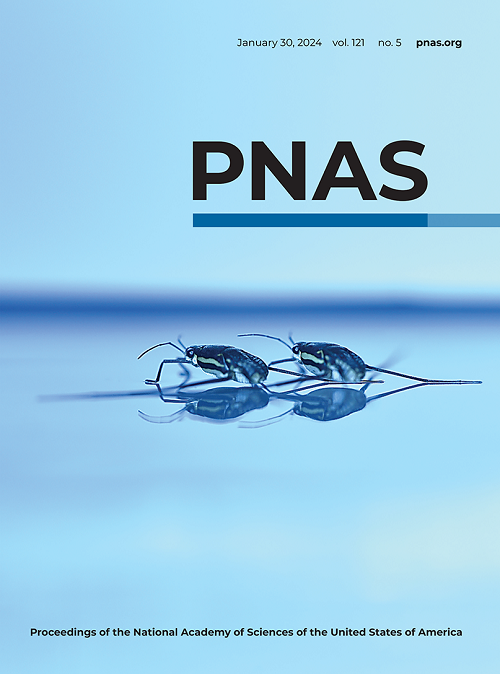小鼠成熟脂肪细胞中MOB1缺失可改善肥胖和糖尿病
IF 9.4
1区 综合性期刊
Q1 MULTIDISCIPLINARY SCIENCES
Proceedings of the National Academy of Sciences of the United States of America
Pub Date : 2025-04-21
DOI:10.1073/pnas.2424741122
引用次数: 0
摘要
由于运动量减少、食物摄入过多和/或遗传易感性,肥胖和肥胖相关疾病(如 2 型糖尿病)目前在全球流行。Hippo-YAP1通路作为潜在的治疗靶点引起了人们的关注,因为YAP1/TAZ在体外激活小鼠未成熟脂肪细胞后,会通过抑制PPARγ的活性来抑制其分化。然而,YAP1 在体内成熟脂肪细胞中的激活作用仍不清楚。MOB1在肥胖症中的表达增加,它是Hippo核心分子复合物的枢纽,负向调节YAP1/TAZ的激活。因此,我们产生了 aMob1DKO 突变小鼠,其特征是成熟脂肪细胞中特异性缺乏 Mob1a/b。与对照组相比,接受高脂饮食的 aMob1DKO 小鼠表现出有益的变化,这与对饮食诱导的肥胖的抵抗力是一致的。突变体表现出基础脂肪分解、"beiging "和能量消耗的增加,以及白色脂肪组织中 ROS 生成和炎症的抑制。胰岛素敏感性和葡萄糖耐量得到改善,异位脂肪堆积减少。这些变化大多取决于在 aMob1DKO 小鼠的成熟白色脂肪组织中观察到的 YAP1 激活。改善脂质代谢的 FGF21 通过 YAP1 激活直接上调,aMob1DKO 小鼠的许多表型也依赖于 FGF21。因此,aMob1DKO 小鼠是研究饮食诱导肥胖的代谢影响和糖尿病保护的有趣模型。我们的工作表明,脂肪细胞中存在一个 YAP1-FGF21 轴,它可能是肥胖症的潜在治疗靶点。本文章由计算机程序翻译,如有差异,请以英文原文为准。
MOB1 deletion in murine mature adipocytes ameliorates obesity and diabetes
There is currently a global epidemic of obesity and obesity-related diseases such as type 2 diabetes due to decreased physical activity, excessive food intake, and/or genetic predisposition. The Hippo-YAP1 pathway has attracted attention as a potential therapeutic target because YAP1/TAZ activation in murine immature adipocytes in vitro suppresses their differentiation by inhibiting PPARγ activity. However, the role of YAP1 activation in mature adipocytes in vivo remains unclear. MOB1, whose expression is increased in obesity, is the hub of the Hippo core molecule complex and negatively regulates YAP1/TAZ activation. Therefore, we generated aMob1DKO mutant mice, which feature deficiency of Mob1a/b specifically in mature adipocytes. Compared to controls, aMob1DKO mice subjected to a high-fat diet showed beneficial changes consistent with resistance to diet-induced obesity. The mutants exhibited increases in basal lipolysis, “beiging,” and energy expenditure, as well as suppression of ROS production and inflammation in white adipose tissue. Insulin sensitivity and glucose tolerance were improved, and ectopic fat accumulation was reduced. Most of these changes were dependent on the YAP1 activation observed in mature white adipose tissue of aMob1DKO mice. FGF21, which improves lipid metabolism, was upregulated directly via YAP1 activation, and many of the phenotypes seen in aMob1DKO mice were also dependent on FGF21. Thus, the aMob1DKO mouse is an interesting model for the study of the metabolic effects of diet-induced obesity and protection against diabetes. Our work suggests that a YAP1-FGF21 axis exists in adipocytes that may be a potential therapeutic target for obesity.
求助全文
通过发布文献求助,成功后即可免费获取论文全文。
去求助
来源期刊
CiteScore
19.00
自引率
0.90%
发文量
3575
审稿时长
2.5 months
期刊介绍:
The Proceedings of the National Academy of Sciences (PNAS), a peer-reviewed journal of the National Academy of Sciences (NAS), serves as an authoritative source for high-impact, original research across the biological, physical, and social sciences. With a global scope, the journal welcomes submissions from researchers worldwide, making it an inclusive platform for advancing scientific knowledge.

 求助内容:
求助内容: 应助结果提醒方式:
应助结果提醒方式:


